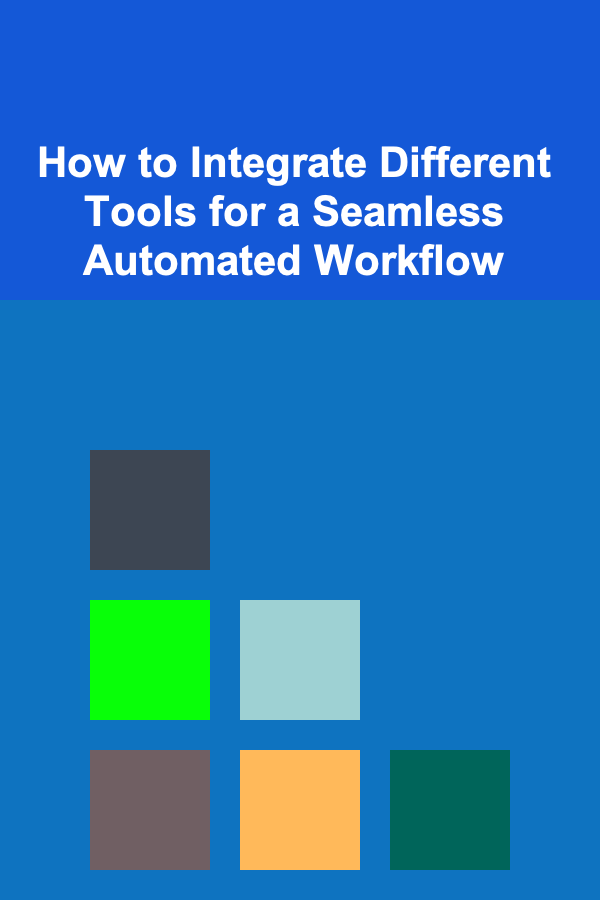
How to Integrate Different Tools for a Seamless Automated Workflow
ebook include PDF & Audio bundle (Micro Guide)
$12.99$10.99
Limited Time Offer! Order within the next:

In today's fast-paced digital landscape, efficiency and productivity are crucial to success. One of the most effective ways to enhance operational efficiency is by automating workflows, reducing manual tasks, and streamlining processes. However, the real power of automation emerges when different tools and platforms are integrated seamlessly, allowing them to work together without friction.
In this actionable guide, we will explore how to integrate various tools into a cohesive automated workflow, ensuring that tasks are handled efficiently, data flows smoothly, and your business can scale without complexity. Whether you're using a CRM, email marketing software, project management tools, or any other platform, the right integrations can drastically improve how you work.
Understanding the Importance of Tool Integration
Before diving into the "how," it's essential to understand why integrating tools is vital. The core benefits of creating an automated workflow through integration include:
- Increased Efficiency: Reducing the need for manual data entry, handoffs between systems, or repetitive tasks saves time and effort.
- Improved Accuracy: Automation reduces human error, ensuring that data is transferred accurately across systems.
- Streamlined Communication: When tools are integrated, teams can share data seamlessly, leading to more effective communication and collaboration.
- Scalability: An integrated system allows your business to scale more easily by managing larger volumes of data and tasks without adding complexity.
Now, let's break down how to approach tool integration for an efficient automated workflow.
Step 1: Assess Your Needs and Identify Key Tools
The first step in building a seamless automated workflow is assessing your business's specific needs and identifying the tools that will work together to meet those needs. This might include:
- Customer Relationship Management (CRM): Tools like Salesforce, HubSpot, or Zoho CRM that manage customer data, track interactions, and handle lead generation.
- Project Management Tools : Platforms like Asana, Trello, or Monday.com to organize tasks, track progress, and collaborate with teams.
- Marketing Automation: Tools like Mailchimp, ActiveCampaign, or Marketo to automate email campaigns, social media posts, and other marketing efforts.
- Accounting and Invoicing: Software such as QuickBooks or Xero to manage finances, track expenses, and issue invoices.
- File Storage and Document Management: Google Drive, Dropbox, or Box for storing and sharing documents and files.
- Communication Platforms: Slack, Microsoft Teams, or Zoom for messaging and video communication.
Actionable Tip:
Start by mapping out your current workflows. Document the tools you currently use and where inefficiencies or gaps exist. Then, prioritize integrating tools that directly address these pain points, focusing on the highest impact areas first.
Step 2: Choose Integration Platforms
Once you know which tools you want to integrate, you need to determine how you'll make them work together. There are a few common ways to approach this:
1. Native Integrations
Many modern software platforms come with built-in integrations with other widely-used tools. These native integrations are usually the easiest to implement because they are already built into the system.
For example:
- HubSpot CRM integrates seamlessly with Gmail, Google Calendar, and Slack.
- Trello integrates with Google Drive and Slack to allow smooth task management and file sharing.
Actionable Tip:
Check your tools' settings or documentation for any pre-built integrations. Native integrations are often the quickest, most reliable way to connect your tools.
2. Third-Party Integration Platforms
If your tools don't offer native integrations, third-party platforms such as Zapier, Integromat (now Make), or Tray.io can bridge the gap. These platforms allow you to create automated workflows between apps without writing any code.
For instance:
- Zapier: Automates tasks by connecting apps like Google Sheets, Mailchimp, and Trello. You can create "Zaps" to trigger actions in one app based on events in another.
- Integromat: Provides more advanced workflows and supports a larger number of apps and APIs, making it ideal for complex integrations.
Actionable Tip:
If you have a few tools that don't integrate directly, start with Zapier or Integromat. They offer pre-configured "recipes" or "scenarios" that allow you to get started quickly, and they have robust documentation for building custom workflows.
3. Custom API Integrations
For businesses with more unique or complex needs, custom API integrations may be necessary. This requires more technical expertise but provides complete control over how your tools communicate with each other.
Custom API integrations are suitable if:
- Your tools don't have native integrations or work with third-party platforms.
- You require highly customized workflows that are not supported by existing tools.
- Your systems require secure, real-time data exchange between multiple platforms.
Actionable Tip:
If you need custom API integrations, work with a developer or a system integrator who can build the necessary connections. Define the specific data flows you need, and ensure that security and data privacy regulations are met.
Step 3: Design Your Automated Workflow
With your tools selected and integration platform in place, it's time to design your automated workflow. The goal is to create a seamless flow of data and tasks that requires minimal human intervention.
Here's a step-by-step approach:
1. Map Out the Workflow
Start by outlining how data should flow between the various systems and what tasks need to be automated. For example:
- When a new lead is captured in your CRM, it automatically triggers an email campaign in your email marketing software.
- A project in your project management tool is created when a new contract is signed, with tasks automatically assigned to team members.
2. Identify Triggers and Actions
In most integration platforms, you will work with a "trigger-action" system. A trigger is an event that occurs in one tool, and the action is the result in another tool. For instance:
- Trigger: A new customer is added to your CRM.
- Action: Add them to a mailing list in your email marketing tool.
3. Ensure Data Consistency
Ensure that data is consistently updated across all platforms. For example, if a customer updates their contact information in your CRM, that update should automatically reflect in your email marketing tool and any other platforms that store customer data.
4. Test the Workflow
Before fully launching your automated workflow, test it thoroughly to ensure it functions as expected. Check that all triggers activate properly and that data flows smoothly between systems without errors.
Actionable Tip:
Test workflows in a staged environment or with a subset of data before rolling them out to your entire system. This minimizes the risk of disruptions and errors when you go live.
Step 4: Monitor, Optimize, and Iterate
After setting up your automated workflow, it's essential to continuously monitor its performance and optimize it based on real-world results.
1. Track KPIs and Performance Metrics
Monitor key performance indicators (KPIs) such as task completion time, error rates, and system performance. Tools like Google Analytics, project management dashboards, or in-app analytics can help track progress.
2. Gather Feedback from Teams
Speak with the teams using the automated workflows to gather feedback on any issues or areas for improvement. Are the tools easy to use? Are there any bottlenecks or inefficiencies that need to be addressed?
3. Make Iterative Improvements
Automation is an ongoing process. Over time, you may need to refine or add new steps as your business evolves. Continuously assess your workflows, implement feedback, and test new integrations to keep your processes running smoothly.
Actionable Tip:
Set aside regular intervals (e.g., quarterly or bi-annually) to audit your workflows and identify areas for improvement or automation that can be added.
Conclusion
Integrating different tools into a seamless automated workflow can significantly improve productivity, efficiency, and collaboration. By carefully selecting the right tools, utilizing the appropriate integration platforms, designing automated workflows with triggers and actions, and continuously optimizing your processes, you can create a system that frees up your team's time and ensures consistency in operations.
Remember that the goal of automation is not just to reduce manual effort but to create a frictionless environment where your tools work in concert, allowing your business to scale without adding complexity. By following this actionable guide, you'll be well on your way to building a powerful, integrated workflow that drives success.
Reading More From Our Other Websites
- [Personal Financial Planning 101] How to Build Passive Income Streams and Achieve Financial Freedom
- [Home Cleaning 101] How to Tackle Spring Cleaning When You're Short on Time
- [Trail Running Tip 101] Discover the Unexpected: Sensory Delights of Trail Running in New Terrains
- [Home Renovating 101] How to Budget for a Home Renovation Without Going Overboard
- [Home Party Planning 101] How to Plan a Summer Party: What Are the Top Ideas for a Fun Outdoor Event?
- [Biking 101] How to Fuel Your Ride: The Ultimate Guide to Bike Nutrition
- [Organization Tip 101] How to Organize Receipts for Budgeting Purposes
- [Home Staging 101] How to Implement Spring Home Staging Tips for a Refreshed Look
- [Home Space Saving 101] How to Organize a Space-Saving Laundry Room
- [Home Security 101] How to Protect Your Home from Identity Theft and Fraud

How to Maintain a Clutter-Free Bathroom
Read More
How to Organize Your Home Bar Area with Space-Saving Ideas
Read More
How to Rent a Home Depot Rug Doctor for DIY Carpet Cleaning
Read More
How to Start a Successful Real Estate Agent Career from Scratch
Read More
How to Use Color Psychology to Energize Your Workout Space
Read More
How to Use the Best App to Manage Your Money Without Stress
Read MoreOther Products

How to Maintain a Clutter-Free Bathroom
Read More
How to Organize Your Home Bar Area with Space-Saving Ideas
Read More
How to Rent a Home Depot Rug Doctor for DIY Carpet Cleaning
Read More
How to Start a Successful Real Estate Agent Career from Scratch
Read More
How to Use Color Psychology to Energize Your Workout Space
Read More